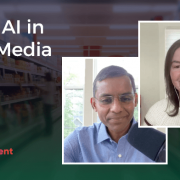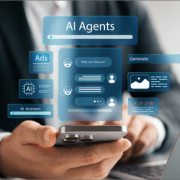Taking a few steps back into history, a lot of time, meaningful interactions, analysis, and creativity went into developing a pixel-perfect dashboard that answered business problems. Even though this can solve complex problems, with an ever-growing need to improve business efficiency at speed, organizations needed a way to handle time-critical problems. It made this a motivation for introducing Self-Service Analytics to let businesses take control of analysing the data by themselves and save time complexities.
In today’s digital age, disruptions in technology have helped organizations to take a step forward in their quest to be data-driven by adopting new ways of self-service analytics which uses data from human conversations or voice. Conversational Analytics has numerous BI use-case applications, and it uses natural language processing (NLP) and cognitive techniques to transform conversational data to insights in seconds.
Let us see how conversational apps are helping organization improve their analytics needs.
Personal Google Assistant for your Data
Revamping the approach of drag and drop in Self-Service BI to offer solutions where customer can use Google like search in their organisation’s data, conversational apps have come a long and interesting way. Conversational Apps interfaces are intelligent enough to understand the user data and offer suggestions making it easier for the user to execute their query. Users can easily apply filters or calculations on a search query. Just like Google lists the search results instantly irrespective of the volume of data it processes, these apps have been designed to handle vast gamut of data to give instant result.
Empower Users with Simple Intuitive Interface
Another and most important aspect of modernizing today’s BI is to empower as many users as possible since the analytics adoption rate still rests at just 30%. Even after advancements in self-service sector, 84% of frontline workers report poor analytics experiences and need better insights technology. It should be easier for every user to interact with data through natural language queries (NLQ), search, voice, helping them focus on the reasons and key drivers derived from the data. Providing the users with a simple but intuitive interface and not letting them worry about data complexities due to inbuilt and advanced natural language processing techniques, brings the much-needed change. This way conversational analytics can bridge the gap by targeting the business savvy users and pushing the analytics adoption to 50% thus contributing to better reach.
Visualizations Coupled with Natural Language Narratives
It is also important to understand and portray what your data knows. Whilst conversational applications are being equipped to know what data values are being looked for and then build the most meaningful story from the extract, it also proactively adds different perspectives by representing in the best possible visualization or letting the user choose one from the existing stack. One can also see an apt implementation of natural language generation (NLG) to narrate these perspectives. These apps are also developer-friendly to give more flexibility for the business users to present the story the way they want and where they want. Easy configuration options and availability of a range of APIs makes this possible and allows businesses to focus on deriving value from their data.
Personalized Insights
Even though text and voice-based search interfaces give conversational apps the edge over traditional Self-Service Analytics, what makes conversational apps more interesting is its ability to understand insights that are relevant to the users using cognitive techniques. This knowledge is then used to proactively discover similar analysis. Be it relevant insights across the department or organization, conversational apps bring them closer to you by recommending them on your homepage. This level of “Personalization” helps business gain insights into their preferences and intent through data. Shaping up your data so easily and giving a personalized touch makes Conversational Apps more appealing.
AI-Driven Deep Insights
Conversational apps leverage AI-ML right from pulling and understanding customer data or schema, to gathering insights from it. Be it diagnostic, prescriptive, or predictive analysis, these apps are rapidly evolving with every new version, giving more options for businesses to explore their data and take business decisions instantly. They offer integration solutions which uses the latest and trending data engineering tools that expand the scope of implementing complex and use-case-specific machine learning models on any given data. With these solutions at their fingertips, businesses can now envision how AI-ML can bring more meaning to their data and focus their AI investments in the right direction. Advancements in NLP and ML techniques combined with increasing maturity of conversational AI and RPA platforms can help businesses find deeper insights from large volumes of conversational data.
To summarize, in a BI landscape conversational apps have given more control of the BI-layer to business users. By building smarter personalized interfaces and bringing AI to the doorstep, conversational apps are expanding the horizons of Self-Service BI making it simpler for business to increase their adoption rate.
At Infocepts
Infocepts Conversational app solutions allow customers to adopt and embed conversational capabilities without having to worry about platform complexities and management. Infocepts’ proprietary accelerators built to work across platforms, leverage AI, ML, NLG to make exploratory insights quickly available to all users.
Be it integration of NLP capabilities in existing BI setup or creating and managing a new conversational apps platform like ThoughtSpot or Power BI Q&A, one can get started with modernizing their BI stack instantly and take the first step towards data-driven modernization.
Recent Blogs

Bots to Brains: How Agentic AI is Changing the Game
July 8, 2025

The Future of Supply Chains Is AI-Driven—Is Your Business Ready to Embrace the Change?
July 2, 2025

What Retail Media Can Learn from Instacart’s AI Strategy
June 24, 2025

Beyond Chatbots: How Agentic AI Is Automating High-Stakes Business Decisions
June 11, 2025


